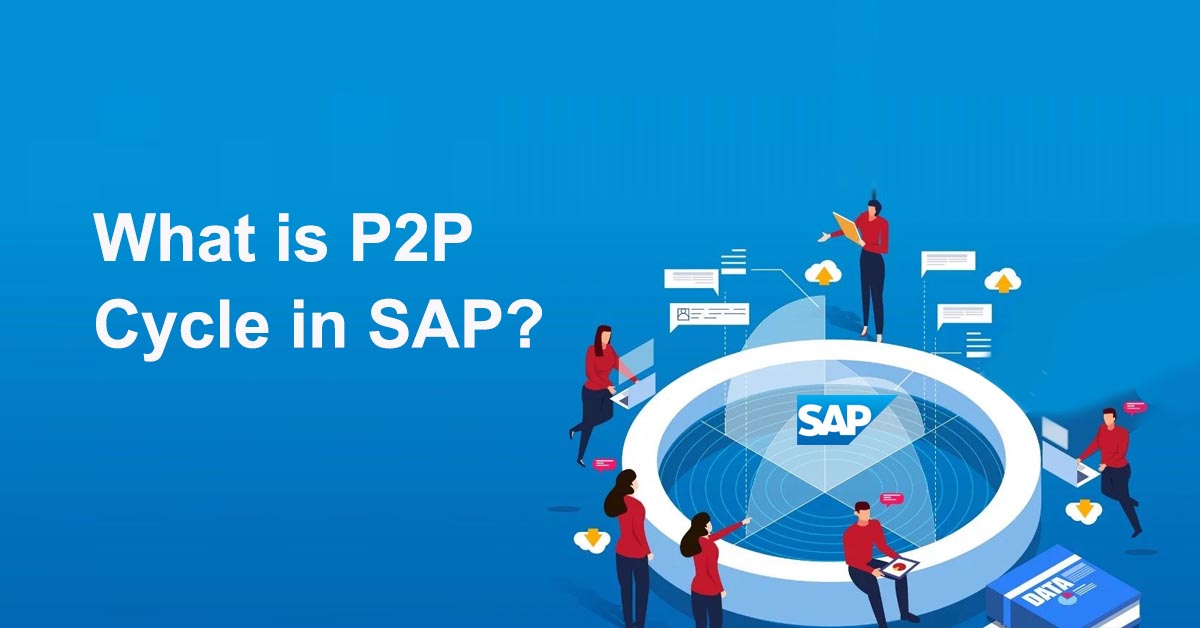What is P2P Cycle in SAP?
Organizations in today's fast-paced corporate environment are continuously looking for methods to streamline their operations and enhance efficiency. One key area where this is evident is the procure-to-pay process, also known as P2P cycle in SAP. This essential business function encompasses a series of twelve steps that take an organization from identifying its procurement needs all the way to making payments for goods or services received. Understanding the intricacies of this process is crucial for businesses looking to optimize their workflow and maximize cost savings. In this article, we will delve into each step of the P2P cycle in SAP, shedding light on its importance and providing practical insights for implementation. So buckle up and get ready to embark on a journey through the fascinating world of procure-to-pay!
Understanding the P2P Cycle in SAP
Understanding the P2P cycle in SAP is essential for optimizing procurement processes and effectively managing company resources. This cycle, also known as the procure-to-pay process, encompasses all the steps from identifying a need for goods or services to making the final payment to the supplier.
The first step in the P2P cycle is creating a purchase requisition, where employees request certain items or services. This requisition is then routed for approval, ensuring proper validation of requests before moving forward. Once approved, a purchase order is generated and sent to the chosen supplier.
Next comes receipt processing, where goods or services are received and verified against the purchase order. This step plays a crucial role in avoiding discrepancies and maintaining accurate inventory records. Upon verification, an invoice is created based on received quantity and purchasing conditions.
It's important to note that effective communication between departments within an organization is key at every stage of the P2P cycle. Ensuring seamless collaboration between procurement teams, finance departments, and suppliers can streamline operations and optimize overall efficiency.
Overall, comprehending each stage of the P2P cycle in SAP allows businesses to identify potential bottlenecks in their procurement processes while implementing effective strategies for improving operational performance. By leveraging SAP's integrated platform capabilities, organizations can gain greater visibility into their supply chain activities and make informed decisions to drive business success. Gain more knowledge on SAP IBP by joining SAP IBP Training!
Step 1: Requisition Creation
The first step in the procure-to-pay process is requisition creation. This is where a user within the organization identifies a need for a particular product or service and creates a requisition to initiate the purchasing process. The requisition includes details such as the item description, quantity required, delivery date, and any other specifications.
Requisition creation plays a crucial role in ensuring that the right products or services are procured at the right time. However, it is important for organizations to establish clear guidelines and approval processes for requisitions to avoid unnecessary purchases or delays. By implementing automated systems, organizations can streamline this step by allowing users to create requisitions online and automatically route them for approval based on predefined workflows.
Successful requisition creation also requires effective communication between various departments within an organization. For instance, if the procurement team has a thorough understanding of upcoming projects or business plans from other departments, they can anticipate future needs and ensure timely procurement of necessary items. Collaboration between departments can help minimize errors in specifications and ensure that all requirements are met accurately during the procurement process.
Overall, effective requisition creation sets the foundation for a smooth procure-to-pay cycle by enabling accurate planning, efficient purchasing decisions, and timely order fulfillment. It serves as an essential starting point that allows organizations to manage their procurement needs effectively while maintaining cost control measures.
Step 2: Purchase Order Generation
Once the procurement requirement has been identified and the necessary approvals are obtained, it is essential to generate a purchase order to formalize the transaction. In this step of the P2P cycle in SAP, the purchasing department creates a purchase order document based on the information provided by the requisitioner.
The purchase order generation process involves inputting details such as vendor information, delivery dates, payment terms, quantities, and prices. It is crucial to ensure accuracy and confirm that all relevant information is included in the purchase order to avoid any potential issues during the later stages of procurement.
In addition to standard purchase orders, organizations may also utilize different types of purchase orders for specific scenarios. For example, blanket purchase orders can be used when there is an ongoing relationship with a supplier for recurring purchases. These POs typically cover multiple deliveries over a specified period without requiring individual release documents.
By implementing an efficient and accurate purchase order generation process within their P2P cycle in SAP, organizations can streamline their procurement processes while ensuring all necessary information is captured for successful transactions. This step also helps facilitate better communication between stakeholders involved in the procurement process, aiding in seamless coordination throughout various stages of buying goods or services.
Step 3: Vendor Selection and Evaluation
Step 3 of the procure-to-pay process is vendor selection and evaluation, a critical stage that can have a significant impact on the entire purchasing cycle. In this step, organizations must carefully assess potential vendors based on certain criteria such as product quality, price competitiveness, reliability, service levels, and overall reputation. It is essential to gather all relevant information about vendors by conducting market research, requesting quotations or proposals, and checking references.
However, selecting the right vendor goes beyond just evaluating their capabilities on paper. It also involves considering factors such as alignment with organizational values and culture. Choosing vendors who share similar values not only ensures smooth collaboration but also enhances long-term partnerships that can benefit both parties. Additionally, some organizations are now prioritizing sustainability when selecting vendors. They look for suppliers who are committed to ethical practices in areas like labor rights or environmental sustainability because these considerations align with their own corporate social responsibility goals.
Ultimately, effective vendor selection requires a comprehensive evaluation process that takes into account various aspects beyond just prices and product quality. By thoroughly vetting potential vendors through research and assessments aligned with the organization's values and objectives, businesses can ensure they make informed decisions that contribute to their overall success in the procure-to-pay process.
Step 4: Goods Receipt
After the purchase order has been sent and the vendor has confirmed the delivery, it is time for the goods receipt. This step is crucial as it ensures that the materials or services ordered have arrived in line with expectations.
In SAP, the goods receipt process involves recording the received quantity and quality of goods in the system. It provides visibility into inventory levels and triggers subsequent activities such as invoice verification and payment processing. Additionally, a proper goods receipt allows for accurate tracking of material movements throughout the supply chain.
By effectively managing goods receipts, organizations can streamline their procurement processes and achieve better control over their inventory. However, this step goes beyond just receiving physical goods; it also entails verifying that they are in good condition, match what was ordered, and conform to any prescribed specifications. Moreover, electronic methods such as using scanners or barcodes can simplify this process by automating data entry tasks.
Successful implementation of effective goods receipt procedures not only supports efficient operational processes but also plays a critical role in maintaining customer satisfaction levels through timely deliveries. By closely monitoring this step in their procure-to-pay cycle, businesses can prevent shortages or stockouts that could lead to delayed order fulfillment or missed opportunities. Furthermore, by promptly checking and inspecting incoming shipments against purchase orders, organizations reduce errors relating to incorrect quantities or damaged items - enabling them to take appropriate action immediately and protect their financial interests.
Step 5: Invoice Verification
Step 5 of the procure-to-pay process in SAP is invoice verification, where the purchase order and goods receipt are matched with the vendor's invoice. This step ensures that all quantities and prices are correct and that there are no discrepancies or errors. Efficient invoice verification plays a crucial role in maintaining accurate financial records and preventing fraudulent activities.
One important feature of invoice verification in SAP is its ability to automatically compare the price on the purchase order with the price on the vendor's invoice, ensuring that no overcharging or undercharging occurs. In addition, by verifying invoices against goods receipts, businesses can identify any discrepancies and take necessary actions such as resolving disputes or requesting credit memos for items not received or damaged goods.
Furthermore, SAP provides various options for automating invoice verification processes, such as implementing electronic invoicing systems. These systems eliminate manual data entry, reduce paper usage, and improve accuracy and efficiency while also streamlining communication between vendors and buyers.
Step 6: Payment Processing
Once the goods or services have been received and accepted by the buyer, it is time for payment processing. This step involves issuing payments to suppliers or vendors for the products or services rendered. In traditional procurement processes, payment processing could be a tedious and time-consuming task involving manual paperwork and multiple approvals. However, modern technology has revolutionized this stage by introducing electronic payment methods such as wire transfers or automatic clearing house (ACH) payments.
One of the key benefits of electronic payment processing is efficiency. By eliminating paper-based transactions and physical checks, businesses can greatly reduce processing time and costs associated with printing, mailing, and reconciling payments. Additionally, electronic payments offer greater security compared to traditional methods – there is no risk of checks getting lost in the mail or falling into the wrong hands. Moreover, with real-time tracking capabilities, both buyers and suppliers can monitor their transaction status conveniently.
Overall, payment processing is a critical component of the procure-to-pay process as it ensures that suppliers are compensated promptly and accurately for their goods or services. By embracing modern digital solutions like electronic payments, organizations can streamline their operations while enhancing transparency and efficiency in financial transactions. As technology continues to advance, we can anticipate further improvements in payment processing methods that will ultimately benefit both buyers and suppliers alike within the P2P cycle.
Step 7: Vendor Performance Evaluation
Once a purchase order is fulfilled and the goods or services are received, it is crucial to evaluate the performance of the vendor. This step helps to ensure that you are working with reliable and high-quality suppliers, ultimately improving your overall procurement process.
Vendor performance evaluation involves assessing different aspects such as delivery time, quality of products or services, responsiveness to queries or complaints, adherence to contracts and agreements, and overall customer satisfaction. By evaluating these factors, you can identify any problem areas with specific vendors and take appropriate actions to rectify them.
An effective way to conduct vendor performance evaluations is by using key performance indicators (KPIs). These measurable metrics provide objective data for evaluating vendor performance on a consistent basis. Some common KPIs include on-time delivery rate, fill rate (the percentage of items delivered from the total ordered), defect rate (the percentage of defective items received), and customer satisfaction ratings.
By regularly evaluating vendors' performances using KPIs, businesses can make informed decisions about their supplier relationships. This not only ensures accountability but also allows for continuous improvement in procurement operations. Moreover, regular feedback provided through vendor evaluations encourages suppliers to maintain high standards of service and fosters a culture of collaboration between buyers and vendors. Overall, this step plays a vital role in maintaining a healthy supplier ecosystem within the procure-to-pay cycle.
Conclusion:
In conclusion, the Procure-To-Pay process in SAP is a critical component of any organization's supply chain management. By leveraging technology and automation, companies are able to streamline their purchasing operations, reduce costs, and improve efficiency. However, it is important to note that successful implementation of the P2P cycle requires careful planning, collaboration between departments, and ongoing monitoring of key metrics.
One key takeaway from this article is the importance of data accuracy and integration. In order for the P2P process to run smoothly, accurate data must be captured at each step along the way. This includes everything from supplier information and product details to pricing and payment terms. Without accurate data in place, organizations risk delays in delivery times, incorrect inventory levels, and ultimately a breakdown in the entire procurement process.
Additionally, it's crucial for organizations to continuously evaluate their P2P processes and look for opportunities to enhance them further. With advancements in technology such as artificial intelligence and machine learning, there are new possibilities for automation within the procure-to-pay cycle. By embracing these innovations and staying ahead of industry trends, companies can revolutionize their procurement practices and gain a competitive edge.
In summary, mastering the 12 steps of SAP's Procure-To-Pay process is essential for achieving operational excellence within your organization. From requisitioning goods or services all the way through to payment processing, every stage plays a vital role in ensuring smooth operations that deliver valuable results.
FAQ’S
1. What is P2P Cycle in SAP?
The P2P (Procure-to-Pay) cycle in SAP refers to the end-to-end process of purchasing goods or services, from the initial procurement request to the payment of invoices.
2. What are the key steps involved in the P2P Cycle?
The key steps in the P2P cycle include requisition creation, purchase order processing, goods receipt, invoice verification, and finally, payment processing.
3. How does the P2P Cycle help streamline procurement processes?
The P2P cycle helps streamline procurement processes by providing a standardized framework for managing purchasing activities, ensuring efficient communication with vendors, and maintaining accurate financial records.
4. Can SAP automatically generate purchase orders within the P2P Cycle?
Yes, SAP can automatically generate purchase orders based on predefined criteria such as material requirements planning (MRP), reorder points, or manually entered requisitions.
5. How does goods receipt fit into the P2P Cycle?
Goods receipt is an important step in the P2P cycle as it involves physically receiving and inspecting the ordered goods or services to ensure they meet specifications before proceeding with invoice verification and payment.
6. Is invoice verification necessary in the P2P Cycle?
Yes, invoice verification is a crucial step in the P2P cycle as it involves matching invoices received from vendors against purchase orders and goods receipts to ensure accuracy and prevent discrepancies.
7. Can SAP automate payment processing within the P2P Cycle?
Yes, SAP can automate payment processing by integrating with banking systems or using electronic funds transfer (EFT) methods for timely settlement of approved invoices.
8. How does SAP support monitoring and reporting within the P2P Cycle?
SAP provides various tools and reports that enable users to monitor key metrics such as order status, delivery performance, invoice aging, vendor evaluation, and spend analysis to facilitate informed decision-making within the P2P cycle.












